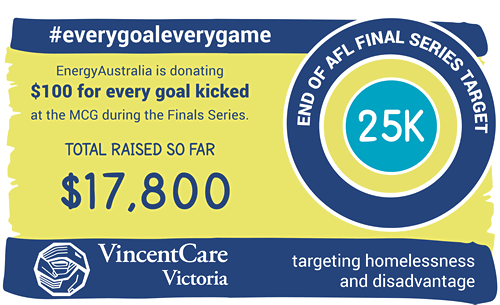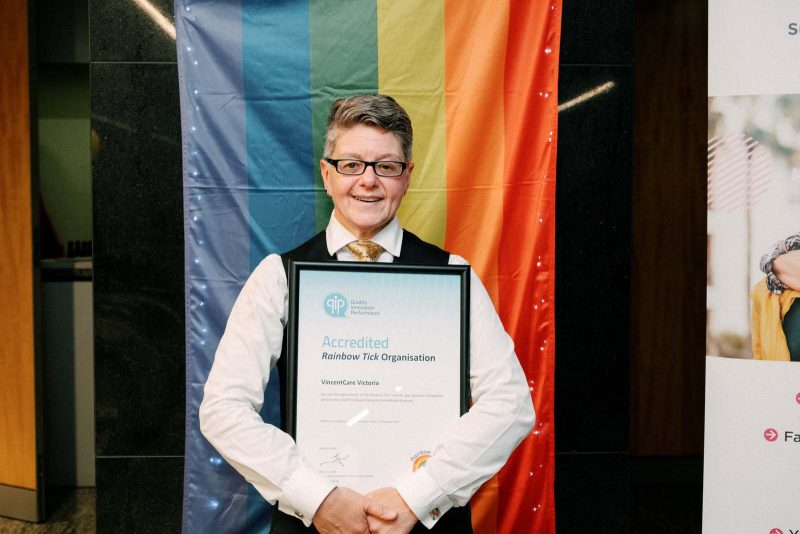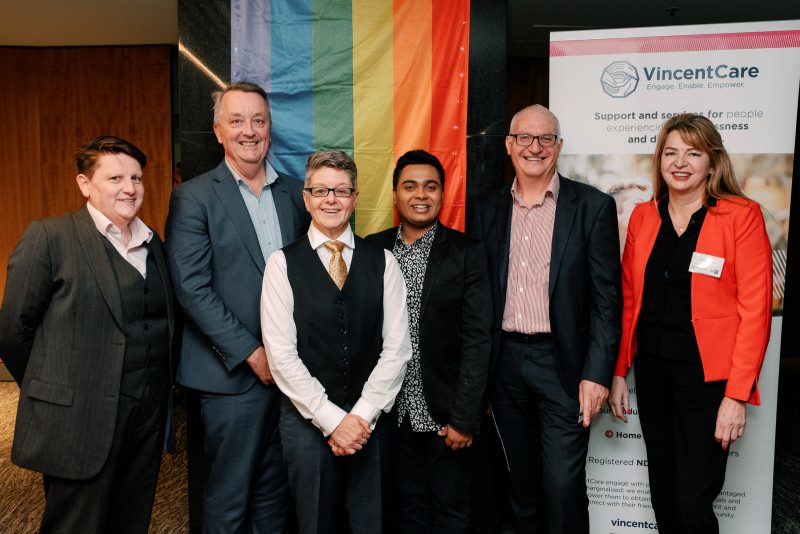
‘A Very Brave Step’: VincentCare and Rainbow Tick Accreditation
Written by Jac Tomlins, Project Coordinator, Gender and Sexuality, VincentCare Victoria

It had been an emotionally charged week — correct that, an emotionally charged four weeks — when I sat in our training room surrounded by VincentCare staff to find out if we had achieved Rainbow Tick accreditation. This day, this moment, was the culmination of 18 months’ work for me, and five years in the making for the organisation. I could not remember the last time I felt this nervous.
On the Monday of that week, the QIP assessment team had descended upon our organisation and ensconced themselves in a large meeting room at Central Office. I had tried to focus on anything except that room, but needless to say, I had failed. Over the next four days, the team had examined over 200 pieces of evidence, conducted dozens of interviews with staff, volunteers and clients, scrutinised numerous policies, practices and procedures, and visited a number of our sites.
For me, Rainbow Tick Accreditation was personal as well as professional. I wanted the staff and volunteers of VincentCare to be recognised for the extraordinary work they had done. But equally, the advocate in me wanted to send a message to the world that any organisation — even a faith-based one, even a Catholic faith based one — can acknowledge, affirm and celebrate the queer community. I wanted our success to be replicated by others — I wanted organisations queuing up around the block to register for Rainbow Tick.
In the training room, the assessor straightened her notes on the table in front of her and addressed the room: ‘It was a well-considered, but very brave step for VincentCare to embark on Rainbow Tick,’ she began, ‘…the result is really well-deserved.’ The entire room heard me exhale.
Rainbow Tick sets the bar high: six standards, sub-divided into a further 26 standards and multiple boxes to tick. It covers everything from governance, risk management, professional development, policies and procedures, client participation, human resources, data collection and documentation and a welcoming physical and digital environment.
Critically, it is about developing a specific and targeted response that understands something of the lived experience of the LGBTIQ+ community, and recognises the historic and current disadvantage experienced by LGBTIQ+ people as a result of ‘minority stress’. We know that where a sub-population of society lives with daily, on-going prejudice, discrimination or stigma, that population will inevitably suffer a range of negative consequences in the long-term. LGBTIQ+ people score lower on all measures of health and well-being than their non-LGBTIQ+ counterparts, and experience higher rates of homelessness.
Until recently, there was relatively little research into LGBTIQ+ people and homelessness, but a new study by the Gay and Lesbian Foundation of Australia, GALFA (now The Rainbow Foundation)1 provided valuable insights and an important evidence base for our accreditation work.
One of the key differences between Rainbow Tick and other accreditations is that Rainbow Tick requires an organisation to achieve and demonstrate cultural change, to show that its workforce is not just accepting of the LGBTIQ+ community, but knowledgeable, confident and skilled, and that this has developed over time.
At VincentCare, we provided professional development training for all staff on working inclusively with LGBTIQ+ people, including separate workshops on elders, youth, the trans and gender diverse community, intimate partner violence, and intersectionality, and we followed up with reflective practice sessions. The feedback on the training was extremely positive with staff feeling well-prepared and confident to implement changes in their daily practice. We also ran surveys of our LGBTIQ+ staff, volunteers and clients and, where appropriate, respondents’ suggestions were implemented.
We reviewed all our policies to ensure the language and content was as inclusive as possible. We revised our Single Client Record data collection procedures to include questions about gender, sexuality, pronouns, and intersex status. We looked at all our Human Resources and volunteer documentation and procedures and made a number of changes to ensure they were as inclusive as possible. We wrote an Inclusive Practice Guide for staff, a resource for clients, and designed our own flyers and posters.
We developed a calendar of key dates in the LGBTIQ+ year and celebrated IDAHOBIT Day and Wear it Purple! For the first time, we had a stall at Midsumma and marched at Pride. We shared some great stories on social media, and made our physical and digital environment about as rainbow as can be.
Our work was guided by a Diverse Gender and Sexuality Committee that met bi-monthly to track progress, provide advice, and brainstorm ideas. My position, Project Coordinator, Gender and Sexuality, sat within the Quality Team that provided an administrative infrastructure, 45 critical advice and guidance, and broad ranging, ongoing support throughout the project.
Where possible, we involved LGBTIQ+ clients, staff and volunteers in the development of any new strategies and initiatives. We also established an LGBTIQ+ Staff Group that met for lunch on non-committee months. The lunches provided staff with an opportunity to discuss a range of issues in a culturally safe and supportive environment. Not only were these discussions enormously valuable, the lunches were great fun.
One of the particular challenges we faced was overcoming traditional community attitudes about faith-based services. Under current legislation, religious organisations can legally discriminate against a person on the basis of their gender identity or sexual orientation. In August 2018, VincentCare, along with nine other faith-based organisations, made an unequivocal, public commitment not to discriminate against LGBTIQ+ people and, further, pledged to provide inclusive services to their LGBTIQ+ clients.
At Temple Beth Israel in St Kilda, Ro Allen, the Victorian Commissioner for Gender and Sexuality, launched a jointly signed statement from those ten faith-based services: We welcome lesbian, gay, bisexual, trans, gender diverse and intersex (LGBTIQ+) people at our services. We pledge to provide inclusive and non-discriminatory services to LGBTIQ+ clients.
That statement was then reproduced and widely distributed throughout our organisation.
So, there was a lot at stake that Friday, sitting in the training room. I wanted to know that we had successfully achieved Rainbow Tick, but it was also really important to me that the assessors saw and understood the full range of work the organisation had done.
When I had taken the job at VincentCare, I really was not sure what to expect. Would staff be fully supportive of this project? What impact was the marriage equality campaign having on people’s views of the community? What kind of attitudes might I rub up against?
What I’d found was genuine and broad support for the LGBTIQ+ community from staff at all levels — and irrespective of faith. The commitment to social justice was universal and deeply felt and, to a person, Rainbow Tick was embraced. It was not just that staff had worked hard to achieve Rainbow Tick, it’s that, collectively, they’d raised their head above the crowd and unequivocally supported the LGBTIQ+ community. Rainbow Tick was the mechanism for change, but the motivation for that change was, purely and simply, a genuine support for the community.
And, much to my relief, the assessors identified all the key elements of the work we’d done. In fact, they said a lot of very nice things about the work we had done — which was a bonus. There were tears, and speeches, and more tears, and then champagne.
For me, this outcome was hugely important. First and foremost it was about ensuring the queer kids who’d been kicked out of home by their families had somewhere to go, and the old gay guys who had been rough sleeping for years might finally feel safe to come out, and the trans folk struggling with unemployment and poverty might be treated with understanding and respect.
But, it was more than that; it was about a large, mainstream organisation prioritising and funding support for the LGBTIQ+ community, and doing that in an unashamed and public way. It was about holding the line at a time when the LGBTIQ+ community was particularly vulnerable and still reeling from the events of the previous two years. And, it was about staff at all levels having the courage to step out of their comfort zone. It was a brave step for VincentCare, but it was actually a thousand brave steps by a host of individual people — and that is how change happens.
Originally published in the May 2019 edition of Parity, the national magazine for Council to Homeless Persons.
1. LGBTQ Homelessness Research Project: LGBTQ Homelessness: Risk, Resilience, and Access to Services in Victoria, Associate Professor Ruth McNair and Dr Cal Andrew, University of Melbourne, and Dr Sharon Parkinson and Associate Professor Deborah Dempsey, Swinburne University.



